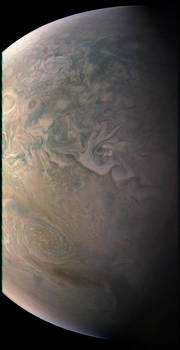2017.01.26:木星の小赤斑の最新画像 [NASA]
NASAが木星探査機ジュノー搭載のジュノーカムで撮影した木星北半球の画像を民間の科学者が画像処理したものを「今日の1枚」で公開しています。

小赤斑を識別しやすく加工したと伝えています。
詳しくは:木星の小赤斑の最新画像
アンチエイジングプラス30パッチ (Anti-Aging Plus) 【パッチMD社製】
オリジナル記事:
Juno’s Close Look at the Little Red Spot
The JunoCam imager on NASA’s Juno spacecraft snapped this shot of Jupiter’s northern latitudes on Dec. 11, 2016 at 8:47 a.m. PST (11:47 a.m. EST), as the spacecraft performed a close flyby of the gas giant planet. The spacecraft was at an altitude of 10,300 miles (16,600 kilometers) above Jupiter’s cloud tops.
NASAの木星探査機ジュノー搭載のジュノーカムで2016年12月11日午前8時47分(太平洋岸時間午後11時47分)に、探査機が木星最接近をしている際に北緯度から巨大なガス惑星である木星を撮影しました。探査機は木星大気上空10,300マイル(16,600キロメートル)の位置にいました。
This stunning view of the high north temperate latitudes fortuitously shows NN-LRS-1, a giant storm known as the Little Red Spot (lower left). This storm is the third largest anticyclonic reddish oval on the planet, which Earth-based observers have tracked for the last 23 years. An anticyclone is a weather phenomenon with large-scale circulation of winds around a central region of high atmospheric pressure. They rotate clockwise in the northern hemisphere, and counterclockwise in the southern hemisphere. The Little Red Spot shows very little color, just a pale brown smudge in the center. The color is very similar to the surroundings, making it difficult to see as it blends in with the clouds nearby. Citizen scientists Gerald Eichstaedt and John Rogers processed the image and drafted the caption.
北北半球の緯度からはは、巨大な赤斑(左下)として知られている巨大な嵐のNN-LRS-1を見ることができます。この嵐は木星で3番目に大きな黄褐色の赤い楕円形で、地球から観測者が過去23年間観測を続けているものです。アンチサイクロンは高気圧の中央領域の周囲で大規模な風が循環する気象現象です。木星の北半球では時計回りに、南半球では反時計回りに回転します。小赤斑は色がほとんどなく中央に薄い茶色の部分があります。色合いが周囲と非常に似ているため周囲の雲と混じり合い観測し難くなります。民間のの科学者ジェラルド・アイヒシュテットとジョン・ロジャースが画像処理して作成しました。
JunoCam’s raw images are available at www.missionjuno.swri.edu/junocam for the public to peruse and process into image products.
ジュノーカムの未加工の画像データは、一般の民間人が閲覧して画像処理できるように以下のURLで公開しています。(注:規約に従う必要があります)www.missionjuno.swri.edu/junocam
JPL manages the Juno mission for the principal investigator, Scott Bolton, of Southwest Research Institute in San Antonio. Juno is part of NASA’s New Frontiers Program, which is managed at NASA’s Marshall Space Flight Center in Huntsville, Alabama, for NASA’s Science Mission Directorate. Lockheed Martin Space Systems, Denver, built the spacecraft. Caltech in Pasadena, California, manages JPL for NASA.
More information about Juno is online at http://www.nasa.gov/juno and http://missionjuno.swri.edu.
Image Credit: NASA/JPL-Caltech/SwRI/MSSS/Gerald Eichstaedt/John Rogers
Last Updated: Jan. 26, 2017
Editor: Tony Greicius
レチンAジェネリック0.1%(Acnelyse)
スポンサーリンク

小赤斑を識別しやすく加工したと伝えています。
詳しくは:木星の小赤斑の最新画像
アンチエイジングプラス30パッチ (Anti-Aging Plus) 【パッチMD社製】
オリジナル記事:
Juno’s Close Look at the Little Red Spot
The JunoCam imager on NASA’s Juno spacecraft snapped this shot of Jupiter’s northern latitudes on Dec. 11, 2016 at 8:47 a.m. PST (11:47 a.m. EST), as the spacecraft performed a close flyby of the gas giant planet. The spacecraft was at an altitude of 10,300 miles (16,600 kilometers) above Jupiter’s cloud tops.
NASAの木星探査機ジュノー搭載のジュノーカムで2016年12月11日午前8時47分(太平洋岸時間午後11時47分)に、探査機が木星最接近をしている際に北緯度から巨大なガス惑星である木星を撮影しました。探査機は木星大気上空10,300マイル(16,600キロメートル)の位置にいました。
This stunning view of the high north temperate latitudes fortuitously shows NN-LRS-1, a giant storm known as the Little Red Spot (lower left). This storm is the third largest anticyclonic reddish oval on the planet, which Earth-based observers have tracked for the last 23 years. An anticyclone is a weather phenomenon with large-scale circulation of winds around a central region of high atmospheric pressure. They rotate clockwise in the northern hemisphere, and counterclockwise in the southern hemisphere. The Little Red Spot shows very little color, just a pale brown smudge in the center. The color is very similar to the surroundings, making it difficult to see as it blends in with the clouds nearby. Citizen scientists Gerald Eichstaedt and John Rogers processed the image and drafted the caption.
北北半球の緯度からはは、巨大な赤斑(左下)として知られている巨大な嵐のNN-LRS-1を見ることができます。この嵐は木星で3番目に大きな黄褐色の赤い楕円形で、地球から観測者が過去23年間観測を続けているものです。アンチサイクロンは高気圧の中央領域の周囲で大規模な風が循環する気象現象です。木星の北半球では時計回りに、南半球では反時計回りに回転します。小赤斑は色がほとんどなく中央に薄い茶色の部分があります。色合いが周囲と非常に似ているため周囲の雲と混じり合い観測し難くなります。民間のの科学者ジェラルド・アイヒシュテットとジョン・ロジャースが画像処理して作成しました。
JunoCam’s raw images are available at www.missionjuno.swri.edu/junocam for the public to peruse and process into image products.
ジュノーカムの未加工の画像データは、一般の民間人が閲覧して画像処理できるように以下のURLで公開しています。(注:規約に従う必要があります)www.missionjuno.swri.edu/junocam
JPL manages the Juno mission for the principal investigator, Scott Bolton, of Southwest Research Institute in San Antonio. Juno is part of NASA’s New Frontiers Program, which is managed at NASA’s Marshall Space Flight Center in Huntsville, Alabama, for NASA’s Science Mission Directorate. Lockheed Martin Space Systems, Denver, built the spacecraft. Caltech in Pasadena, California, manages JPL for NASA.
More information about Juno is online at http://www.nasa.gov/juno and http://missionjuno.swri.edu.
Image Credit: NASA/JPL-Caltech/SwRI/MSSS/Gerald Eichstaedt/John Rogers
Last Updated: Jan. 26, 2017
Editor: Tony Greicius
レチンAジェネリック0.1%(Acnelyse)
スポンサーリンク



